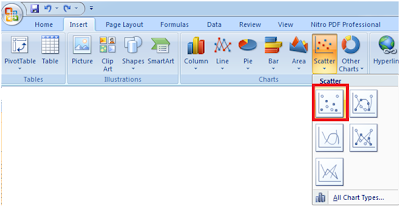Note: Make sure that Data Analysis Add-on is installed with Excel. If not, follow the tutorial Video on YouTube.
Select Function ‘Regression’
Step 1: Getting historical data
Retrieve historical data of scrip price values and benchmark index value for a certain period of time. More the number of observations better it is, as it reduces standard error.
For this tutorial, Monthly closing price for share of Tata Power Ltd. On BSE and Closing value of SENSEX, the BSE Benchmark Index is considered from April 2001 to June 2011, comprising of 122 observations each.
Step 2: Calculate monthly returns on scrip and Index.
Monthly returns for both scrip as well as index are to be calculated.
Formula:
Monthly Return for Month = (Closing Price of the current month – Closing Price of previous month) / Closing Price of previous month
The raw data table in Excel should look like as below,
Scrip: Tata Power Ltd. | ||||
Month | Sensex Close | Closing Price of Scrip | Monthly Market Return (X) | Monthly Scrip Return (Y) |
Apr-01 | 3519.16 | 121.4 | ||
May-01 | 3631.91 | 146.3 | 3.20% | 20.51% |
Jun-01 | 3456.78 | 130.05 | -4.82% | -11.11% |
Jul-01 | 3329.28 | 127.4 | -3.69% | -2.04% |
Aug-01 | 3244.95 | 116.85 | -2.53% | -8.28% |
Sep-01 | 2811.6 | 100.3 | -13.35% | -14.16% |
Oct-01 | 2989.35 | 104.95 | 6.32% | 4.64% |
Nov-01 | 3287.56 | 122.95 | 9.98% | 17.15% |
Dec-01 | 3262.33 | 119.55 | -0.77% | -2.77% |
Jan-02 | 3311.03 | 115.45 | 1.49% | -3.43% |
Feb-02 | 3562.31 | 119.3 | 7.59% | 3.33% |
Mar-02 | 3469.35 | 113.5 | -2.61% | -4.86% |
Apr-02 | 3338.16 | 111.9 | -3.78% | -1.41% |
May-02 | 3125.73 | 114.65 | -6.36% | 2.46% |
Jun-02 | 3244.7 | 130.2 | 3.81% | 13.56% |
Jul-02 | 2987.65 | 103.85 | -7.92% | -20.24% |
Aug-02 | 3181.23 | 102.2 | 6.48% | -1.59% |
Sep-02 | 2991.36 | 95.65 | -5.97% | -6.41% |
Step 3: Run Regression
Method 1: Using Data Analysis Tool
Go to Data Tab, Click ‘Data analysis’
Select Function ‘Regression’
Select market Return as ‘Input Y Range’ and Scrip Return as ‘Input X Range’. To obtain Regression Results on different worksheet/workbook, select appropriate option in Output Options section.
For Tata Power and Sensex Regression, Monthly Scrip Return (Green) is ‘Range Y input’ and Monthly Market Return (Blue) is ‘Range X Input’ as shown below.
Click ‘Ok’ to receive results as shown below,
SUMMARY OUTPUT | ||||||||
Regression Statistics | ||||||||
Multiple R | 0.76592712 | |||||||
R Square | 0.586644353 | |||||||
Adjusted R Square | 0.583199723 | |||||||
Standard Error | 0.076757061 | |||||||
Observations | 122 | |||||||
ANOVA | ||||||||
df | SS | MS | F | Significance F | ||||
Regression | 1 | 1.003388077 | 1.003388 | 170.3069 | 8.99945E-25 | |||
Residual | 120 | 0.706997563 | 0.005892 | |||||
Total | 121 | 1.71038564 | ||||||
Coefficients | Standard Error | t Stat | P-value | Lower 95% | Upper 95% | Lower 95.0% | Upper 95.0% | |
Intercept | 0.006620394 | 0.00710666 | 0.931576 | 0.353426 | -0.007450298 | 0.020691086 | -0.007450298 | 0.020691086 |
X Variable 1 | 1.188147579 | 0.091044613 | 13.05017 | 9E-25 | 1.007885583 | 1.368409574 | 1.007885583 | 1.368409574 |
X Variable 1 is the ‘Beta’ for the scrip.
For Tata Power Beta works out to be 1.188, while R-square is 58.66%.
Method 2: Using Scatter Plot
One can create a regression Beta in Excel using the chart functions. Since Beta is the slope in a regression where market returns are on the X axis and scrip returns are on the Y axis.
Select both Market return (as X) and scrip return (as Y) columns. Go to “Insert>Charts>Scatter”
The Chart should appear like this,
Set the Checkboxes to show line equation and R-Square value on graph.
Final Output:
Slope of the line (1.1881) is ‘Beta’ of scrip.
Working Excel of the Tutorial can be downloaded from here.
Important Links
1. YouTube - Excel Statistics 08: Install Excel 2007 Data Analysis Add-in http://www.youtube.com/watch?v=-ubtpQJ1smI
2. Beta (Finance) (http://en.wikipedia.org/wiki/Beta_(finance))
3. Linear Regression (http://en.wikipedia.org/wiki/Linear_regression)








